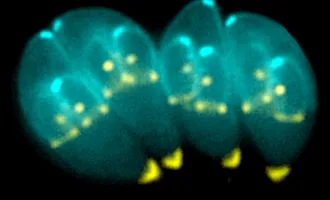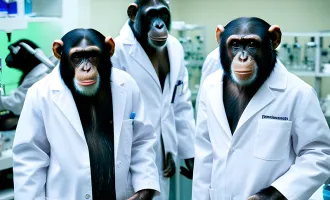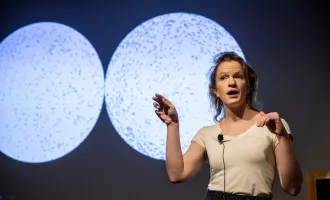Cellular Corporations and the Importance of Cooperation
Cells are more like corporations than they are like people. Uncountable tasks need be accomplished, and each protein is specialized to do one, at most a few, jobs. The job titles are unceremonious and garbled. For example: O-acetylhomoserine aminocarboxypropyltransferase. This enzyme churns out L-methionine, the first amino acid in the creation of every protein. That is all it does.
As in corporations, some proteins are specialized for management. The 25,000 genes in each human cell are turned on and off by a much smaller set of proteins called transcription factors. Transcription factors have executive access, the ability to bind to DNA. Approximately 2,600 human proteins have this ability.
And of course management is stratified. Some transcription factors control the transcription of other transcription factors. A very small set of transcription factors can change the direction of the cellular corporation dramatically.
In 2006, the laboratory of Dr. Shinya Yamanaka reported that adding just four transcription factors to adult mouse fibroblasts (a cell type abundant in connective tissue) could reprogram the cells to a state that resembled that of embryonic stem cells, in which the cells could be coaxed towards morphing into any cell type in the body.
Despite the importance of transcription factors in controlling gene expression and thus determining cell fate, little is known about how transcription factors cooperate with one another. Now, the laboratory of Dr. Benoit Bruneau, who shares a floor with Dr. Yamanaka at the UCSF-affiliated Gladstone Institutes, reports in the recent issue of Cell on the previously underappreciated complexity in interdependent transcription factor function.
The leading author on the paper is Dr. Luis Luna-Zurita, a postdoctoral fellow in Bruneau’s lab, which studies the role of certain transcription factors in the development of the heart. These proteins, particularly TBX5, NKX-2, and GATA4, are at the root of congenital heart defects, which affect 1% of live-born children. Bruneau’s lab wants to understand congenital heart disease and develop therapies that promote cardiac regeneration.
But the TBX5/NKX-2/GATA4 system is also a model for studying how transcription factors cooperate, “for understanding fundamental principles of heterotypic transcription factor interactions,” as stated in the Cell paper (“heterotypic” meaning an interaction between two different transcription factors, as opposed to two of the same).
Two factors that matter with regards to transcription factor function are timing and numbers.
First, timing. Transcription factors are crucially important in development, in making sure that each stage of a growing body occurs in precisely the right order. The Cell paper looked at one specific developmental event, the differentiation of embryonic stem cells into cardiomyocytes, the beating cells of the heart.
The results are almost bewilderingly complex. As the cell identity transitions, factors like TBX5, NKX-2, and GATA4 turn on and off hundreds of genes in precisely timed patterns that may differ drastically from one gene to the next.
Second, numbers. In the context of the cellular corporation, transcription factors like TBX5 are not a single employee, but a team of employees, all with the same job. There are many copies of TBX5 bustling around the nucleus, turning genes on and off. The numbers are critically important. You have two copies of almost every gene (each of which has the capacity to make several corresponding proteins), and if you are missing just one copy of the TBX5 gene, you will develop a condition known as Holt-Oram syndrome: heart defects and limb malformations. If you are missing both copies of TBX5 and somehow still reading this, you have defied medical science.
To regulate all the genes required for cardiac differentiation, you need enough TBX5, enough NKX-2, and enough GATA4. You need both copies of each gene manufacturing large numbers of proteins. But the combinations are important too. This study showed that some genes require two transcription factors to be present at the same place at the same time. This phenomenon is known as interdependence: neither protein can bind the DNA unless the other protein is also present.
Why would this be the case? As I mentioned earlier, transcription factors bind to DNA. But not all protein-DNA interactions are equivalent, not even amongst the same protein. Transcription factors like TBX5 recognize and bind to multiple different DNA sequences, but the strength of the binding can vary depending on the sequence.
TBX5 may not bind to one of these “weaker” sequences unless it can form another stabilizing interaction, for instance to a molecule of NKX-2 that is bound to an adjacent sequence. It’s like holding on with two hands instead of one.
But perhaps more critically, the cooperative action keeps each protein honest. For instance, if NKX-2 is not present, TBX5 will wander throughout the genome and be found in places it ain’t ‘sposed to be, interacting with genes it is not qualified to regulate, answering phones and signing papers in other divisions.
The cooperation that underlies the cellular corporation is easily lost or mismanaged, and the consequences can be worse than a failed company. Because after all, cells are not actually corporations.



